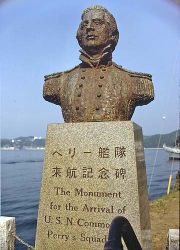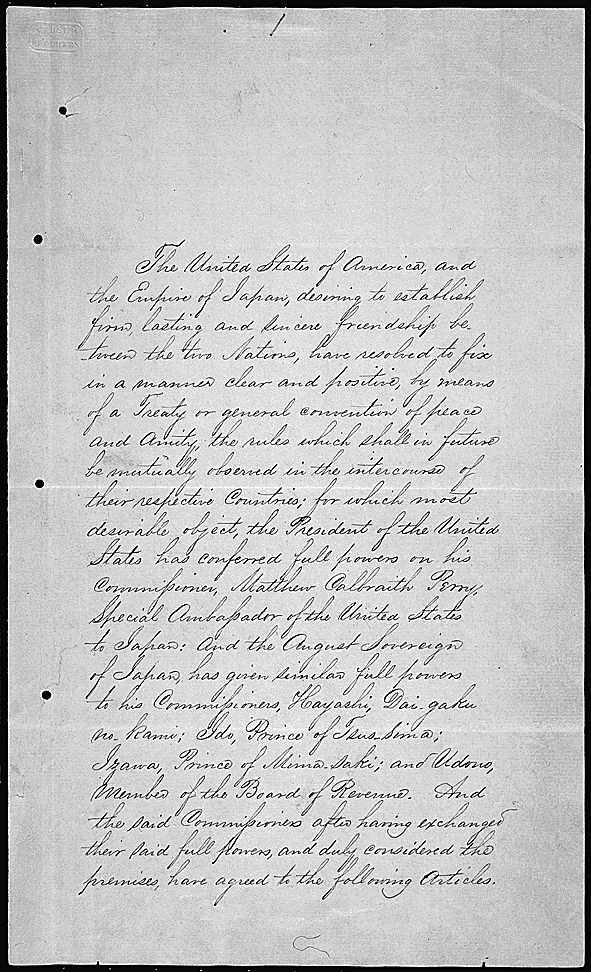
Convention of Kanagawa
Encyclopedia

United States Navy
The United States Navy is the naval warfare service branch of the United States Armed Forces and one of the seven uniformed services of the United States. The U.S. Navy is the largest in the world; its battle fleet tonnage is greater than that of the next 13 largest navies combined. The U.S...
and the Tokugawa shogunate
Tokugawa shogunate
The Tokugawa shogunate, also known as the and the , was a feudal regime of Japan established by Tokugawa Ieyasu and ruled by the shoguns of the Tokugawa family. This period is known as the Edo period and gets its name from the capital city, Edo, which is now called Tokyo, after the name was...
.
Treaty of Peace and Amity (1854)
The treaty opened the Japanese ports of ShimodaShimoda, Shizuoka
is a city and port in Shizuoka, Japan.As of 2010, the city had an estimated population of 25,054 and a population density of 242 persons per square kilometer...
and Hakodate to United States
United States
The United States of America is a federal constitutional republic comprising fifty states and a federal district...
trade and guaranteed the safety of shipwrecked U.S. sailors; however, the treaty did not create a basis for establishing a permanent residence in these locations. The treaty did establish a foundation for the Americans to maintain a permanent consul in Shimoda. The arrival of the fleet would trigger the end of Japan's 200 year policy of seclusion (Sakoku
Sakoku
was the foreign relations policy of Japan under which no foreigner could enter nor could any Japanese leave the country on penalty of death. The policy was enacted by the Tokugawa shogunate under Tokugawa Iemitsu through a number of edicts and policies from 1633–39 and remained in effect until...
).

Shogun
A was one of the hereditary military dictators of Japan from 1192 to 1867. In this period, the shoguns, or their shikken regents , were the de facto rulers of Japan though they were nominally appointed by the emperor...
Tokugawa Ieyoshi
Tokugawa Ieyoshi
Tokugawa Ieyoshi was the 12th shogun of the Tokugawa shogunate of Japan.He was the second son of the 11th shogun, Tokugawa Ienari, and appointed Mizuno Tadakuni to conduct the Tenpo reform....
was the de-facto ruler of Japan; for the Emperor
Emperor of Japan
The Emperor of Japan is, according to the 1947 Constitution of Japan, "the symbol of the state and of the unity of the people." He is a ceremonial figurehead under a form of constitutional monarchy and is head of the Japanese Imperial Family with functions as head of state. He is also the highest...
to interact in any way with foreigners was out of the question. Perry concluded the treaty with representatives of the Shogun
Shogun
A was one of the hereditary military dictators of Japan from 1192 to 1867. In this period, the shoguns, or their shikken regents , were the de facto rulers of Japan though they were nominally appointed by the emperor...
, led by plenipotentiary and the text was reluctantly endorsed subsequently by Emperor Komei
Emperor Komei
was the 121st emperor of Japan, according to the traditional order of succession. Kōmei's reign spanned the years from 1846 through 1867.-Genealogy:Before Kōmei's accession to the Chrysanthemum Throne, his personal name was ;, his title was ....
.
The Treaty was ratified on 21 February 1855.
Later treaties
The Kanagawa treaty was followed by the United States-Japan Treaty of Amity and Commerce, the "Harris Treaty" of 1858, which allowed the establishment of foreign concessions, extraterritoriality for foreigners, and minimal import taxes for foreign goods. The Japanese chafed under the "unequal treaty system" which characterized Asian and western relations during this period.
The Kanagawa treaty became a significant causative factor leading to serious internal conflicts within Japan — an upheaval which was only resolved in 1867 with the end of the Tokugawa shogunate
Tokugawa shogunate
The Tokugawa shogunate, also known as the and the , was a feudal regime of Japan established by Tokugawa Ieyasu and ruled by the shoguns of the Tokugawa family. This period is known as the Edo period and gets its name from the capital city, Edo, which is now called Tokyo, after the name was...
and the beginning of the Meiji Restoration
Meiji Restoration
The , also known as the Meiji Ishin, Revolution, Reform or Renewal, was a chain of events that restored imperial rule to Japan in 1868...
.
Similar treaties were subsequently negotiated by the United Kingdom
United Kingdom
The United Kingdom of Great Britain and Northern IrelandIn the United Kingdom and Dependencies, other languages have been officially recognised as legitimate autochthonous languages under the European Charter for Regional or Minority Languages...
(Anglo-Japanese Friendship Treaty
Anglo-Japanese Friendship Treaty
The between Britain and Japan was signed October 14, 1854 in Nagasaki. The United Kingdom was represented by Admiral Sir James Stirling, with the governors of Nagasaki representing the Tokugawa shogunate ....
, October 1854), the Russians
Russians
The Russian people are an East Slavic ethnic group native to Russia, speaking the Russian language and primarily living in Russia and neighboring countries....
(Treaty of Shimoda
Treaty of Shimoda
The Treaty of Shimoda of 1855, formally Treaty of Commerce and Navigation between Japan and Russia , was signed between the Russian Vice-Admiral Euphimy Vasil'evich Putiatin and Toshiakira Kawaji of Japan in the city of Shimoda, Izu Province, Japan, on February 7, 1855...
, 7 February 1855), the French
French people
The French are a nation that share a common French culture and speak the French language as a mother tongue. Historically, the French population are descended from peoples of Celtic, Latin and Germanic origin, and are today a mixture of several ethnic groups...
(Treaty of Amity and Commerce between France and Japan
Treaty of Amity and Commerce between France and Japan
The Treaty of Amity and Commerce between France and Japan was signed in Edo on October 9, 1858, by Jean-Baptiste Louis Gros, the commander of the French expedition in China, assisted by Charles de Chassiron and Alfred de Moges, opening diplomatic relations between the two countries...
, 9 October 1858).
Kanagawa Treaty House
The Convention was negotiated and was then signed in a purpose-built house in YokohamaYokohama
is the capital city of Kanagawa Prefecture and the second largest city in Japan by population after Tokyo and most populous municipality of Japan. It lies on Tokyo Bay, south of Tokyo, in the Kantō region of the main island of Honshu...
, Japan
Japan
Japan is an island nation in East Asia. Located in the Pacific Ocean, it lies to the east of the Sea of Japan, China, North Korea, South Korea and Russia, stretching from the Sea of Okhotsk in the north to the East China Sea and Taiwan in the south...
.
See also
- Hayashi AkiraHayashi Akirawas a Edo period scholar-diplomat serving the Tokugawa Shogunate in a variety of roles similar to those performed by serial Hayashi clan neo-Confucianists since the time of Tokugawa Ieyasu...
- Sō YoshinoriSō Yoshinoriwas a Sō clan daimyō of the island domain of Tsushima at the end of Japan's Edo period.Yoshinori was the head of the Sō clan from 1842 through 1862.-Black ships:...
- Anglo-Japanese Friendship TreatyAnglo-Japanese Friendship TreatyThe between Britain and Japan was signed October 14, 1854 in Nagasaki. The United Kingdom was represented by Admiral Sir James Stirling, with the governors of Nagasaki representing the Tokugawa shogunate ....
- Treaty of ShimodaTreaty of ShimodaThe Treaty of Shimoda of 1855, formally Treaty of Commerce and Navigation between Japan and Russia , was signed between the Russian Vice-Admiral Euphimy Vasil'evich Putiatin and Toshiakira Kawaji of Japan in the city of Shimoda, Izu Province, Japan, on February 7, 1855...
- United States-Japan Treaty of Amity and Commerce

